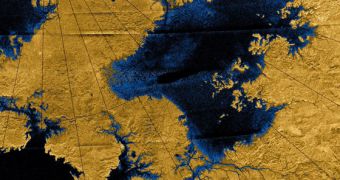A team of experts at the Massachusetts Institute of Technology (MIT), in Cambridge, and the University of Tennessee in Knoxville recently analyzed a large volume of data on the Titan, and noticed that rivers running on the surface of the moon did not erode the landscape as much as they should have.
Titan is the largest moon around Saturn, and is the closest analog to Earth in the entire solar system. It features the same atmospheric and land cycles as our planet, except the main roles are played by liquid hydrocarbons such as methane and ethane, rather than water.
The moon also has a large number of rivers flowing into its hydrocarbon lakes, especially at the poles. However, studies conducted by the NASA Cassini orbiter have revealed little to no signs of erosion.
On Earth, water erosion is responsible for carving out the land, and is capable of producing magnificent structures, such as the Grand Canyon. No such landscape features exist on Titan, and scientists have been trying to figure out why that is for a long time.
According to the new study, there are only two possible explanations for this weird lack of erosion – either the process takes place extremely slow, or other geological phenomena recently wiped its marks off the face of Titan.
Details of the new study have been accepted for publication in an upcoming issue of the esteemed Journal of Geophysical Research-Planets. Scientists believe that the absence of erosion may be tied to the relative lack of impact craters on Titan.
“It's a surface that should have eroded much more than what we're seeing, if the river networks have been active for a long time. It raises some very interesting questions about what has been happening on Titan in the last billion years,” study investigator Taylor Perron explains.
The expert holds an appointment as the Cecil and Ida Green Assistant Professor of Geology at MIT.
“We don't have many impact craters on Earth. People flock to them because they're so few, and one explanation is that Earth's continents are always eroding or being covered with sediment. That may be the case on Titan, too,” the researcher says.
The surface of the Saturnine moon may in fact be just 100 million to 1 billion years old, which is significant younger than the surfaces of other bodies in the solar system, except Earth.
On our planet, some of the factors that continuously reshape the landscape include plate tectonics, erupting volcanoes, advancing glaciers and river networks. It could be that these processes, or similar ones, are active on Titan as well.

 14 DAY TRIAL //
14 DAY TRIAL //